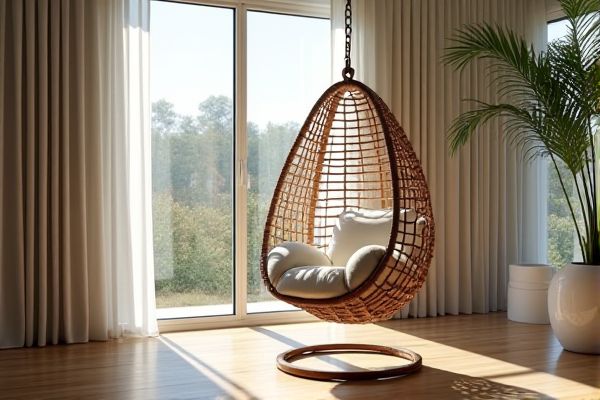
Hanging egg chairs offer a cozy, enclosed design perfect for creating a private relaxation nook, while hammock chairs provide a more open and swaying experience ideal for gentle outdoor lounging. Explore the rest of the article to discover which option best suits Your comfort and style preferences.
Table of Comparison
| Feature | Hanging Egg Chair | Hammock Chair |
|---|---|---|
| Design | Curved, enclosed egg-shaped seat | Open, sling-style fabric seat |
| Comfort | Supportive, cushioned for ergonomic seating | Flexible, cradling with gentle swing motion |
| Material | Typically rattan, wicker, or metal frame with cushions | Fabric or woven cotton, nylon hanging cords |
| Installation | Requires sturdy overhead support or frame stand | Needs strong overhead beam or frame for suspension |
| Space Requirement | Moderate indoor/outdoor footprint, needs clearance | Compact footprint, flexible placement options |
| Weight Capacity | Usually 250-300 lbs (113-136 kg) | Typically 250-350 lbs (113-159 kg) |
| Portability | Less portable, heavier build | Lightweight, easier to move |
| Style & Aesthetics | Modern, stylish, statement piece | Casual, bohemian, relaxed vibe |
| Price Range | Higher, $150-$500+ | Lower to mid, $50-$200 |
Introduction: Hanging Egg Chair vs Hammock Chair
Hanging egg chairs feature a sturdy frame with a cozy, enclosed design offering ergonomic support, ideal for both indoor and outdoor settings. Hammock chairs, made from fabric or woven materials, provide a lightweight and flexible seating option that gently sways, perfect for relaxation. Both seating styles enhance outdoor lounges, patios, or reading nooks, with differences in structure, comfort, and aesthetic appeal influencing user preference.
Aesthetic Appeal and Design Differences
Hanging egg chairs feature a rounded, enclosed structure with woven or rattan designs that create a cozy, modern aesthetic ideal for both indoor and outdoor spaces. Hammock chairs emphasize a more relaxed, open fabric or rope construction that evokes a bohemian or tropical vibe, often allowing for greater airflow and comfort. The egg chair's sculptural form offers a more defined seating area, while the hammock chair's loose, swinging design prioritizes softness and flexibility in style.
Comfort and Ergonomics
Hanging egg chairs offer a cocoon-like design that supports the back and neck, promoting better posture and ergonomic comfort during prolonged use. Hammock chairs provide a more flexible seating experience that molds to the body's shape, distributing weight evenly to reduce pressure points. Both options enhance relaxation, but the structured support of hanging egg chairs typically leads to improved spinal alignment compared to the softer, less structured hammock chair.
Installation and Space Requirements
Hanging egg chairs require a sturdy ceiling mount or a strong support frame, typically needing professional installation to ensure safety and stability. Hammock chairs often come with adjustable hanging kits and can be installed both indoors and outdoors with minimal tools, needing less structural support compared to egg chairs. Space-wise, egg chairs demand more clearance due to their bulkier frame, whereas hammock chairs are more flexible and suitable for smaller areas or tight corners.
Durability and Material Comparison
Hanging egg chairs are typically crafted from sturdy materials such as powder-coated steel frames and synthetic rattan, offering enhanced durability and resistance to weather conditions compared to hammock chairs, which often use fabric or cotton materials that can wear out faster when exposed to outdoor elements. The synthetic wicker and metal construction of egg chairs provide better structural support and longevity, making them ideal for long-term outdoor use. Hammock chairs offer more flexibility and comfort but require regular maintenance to prevent fabric deterioration and fading.
Indoor vs Outdoor Suitability
Hanging egg chairs are ideal for both indoor and outdoor use due to their sturdy frames and weather-resistant materials, offering versatile placement options for your living room, patio, or garden. Hammock chairs excel in outdoor settings, providing breathable comfort and easy installation between trees or sturdy supports, but some designs also work well indoors if mounted securely. Choosing between the two depends on your space requirements, weather exposure, and style preferences to ensure durability and comfort.
Maintenance and Cleaning
Hanging egg chairs typically require spot cleaning with mild soap and water due to their rattan or wicker material, while hammock chairs often use removable, machine-washable fabric covers for easier maintenance. Both types benefit from regular dusting and avoidance of prolonged exposure to harsh weather to prevent fading and material degradation. Proper storage during off-seasons significantly extends the lifespan of both hanging egg chairs and hammock chairs by protecting them from moisture and UV damage.
Price and Value for Money
Hanging egg chairs typically range from $150 to $400, offering stylish design and sturdy frames that suit both indoor and outdoor spaces, providing strong durability and comfort at a moderate price. Hammock chairs are usually more affordable, priced between $50 and $150, delivering excellent value for money with lightweight, portable designs ideal for casual relaxation and easy installation. Comparing both, hanging egg chairs justify higher costs with enhanced structural support and aesthetic appeal, while hammock chairs maximize budget efficiency for users prioritizing simplicity and mobility.
Pros and Cons: Hanging Egg Chair
Hanging egg chairs offer a stylish and comfortable seating option with a sturdy frame that supports ergonomic posture and provides a cozy, enclosed space ideal for relaxation. They are more durable and weather-resistant compared to hammock chairs, making them suitable for both indoor and outdoor use, but they typically require more space and a strong mounting point for installation. However, their rigid structure may limit movement and flexibility, and they often come at a higher price point than hammock chairs.
Pros and Cons: Hammock Chair
Hammock chairs offer excellent comfort and space-saving design, making them perfect for both indoor and outdoor use. Your seating experience benefits from the gentle swinging motion and versatility, but keep in mind they often require sturdy support and can be less stable than hanging egg chairs. Despite limited cushioning and snug seating, hammock chairs remain a popular choice for relaxation and casual lounging.
 homyna.com
homyna.com